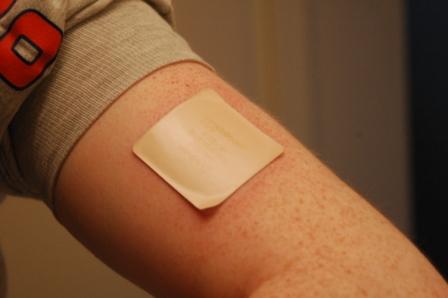Transdermal patch

A transdermal patch or skin patch is a medicated adhesive patch that is placed on the skin to deliver a time released dose of medication through the skin and into the bloodstream. A wide variety of pharmaceuticals can be delivered by transdermal patches. The first commercially available prescription patch was approved by the U.S. Food and Drug Administration in December 1979, which administered scopolamine for motion sickness.[1][2]
The highest selling transdermal patch in the United States is the nicotine patch which releases nicotine to help with cessation of tobacco smoking. Other skin patches administer estrogen for menopause. This also seems to prevent osteoporosis after menopause. Nitroglycerin patches for angina and lidocaine patches to relieve the peripheral pain of shingles (herpes zoster) are also available. Recent developments expanded their use to the delivery of hormonal contraceptives, antidepressants and even pain killers and stimulants for Attention Deficit Hyperactivity Disorder/ADHD. Some pharmaceuticals must be combined with substances, such as alcohol within the patch to increase their ability to penetrate the skin in order to be used in a transdermal patch. Molecules of insulin and many other drugs, however, are too large to pass through the skin.
In 2005, the Food and Drug Administration announced that they are investigating reports of death and other serious adverse events related to narcotic overdose in patients using Duragesic, the fentanyl transdermal patch for pain control. The Duragesic product label was subsequently updated to add safety information in June 2005.[3]
Components
The main components to a transdermal patch are:
- Liner - Protects the patch during storage. The liner is removed prior to use.
- Drug - Drug solution in direct contact with release liner
- Adhesive - Serves to adhere the components of the patch together along with adhering the patch to the skin
- Membrane - Controls the release of the drug from the reservoir and multi-layer patches
- Backing - Protects the patch from the outer environment
Types
There are four main types of transdermal patches listed below.
Single-layer Drug-in-Adhesive
The adhesive layer of this system also contains the drug. In this type of patch the adhesive layer not only serves to adhere the various layers together, along with the entire system to the skin, but is also responsible for the releasing of the drug. The adhesive layer is surrounded by a temporary liner and a backing.
Multi-layer Drug-in-Adhesive
The multi-layer drug-in adhesive patch is similar to the single-layer system in that both adhesive layers are also responsible for the releasing of the drug. The multi-layer system is different however that it adds another layer of drug-in-adhesive, usually separated by a membrane (but not in all cases). This patch also has a temporary liner-layer and a permanent backing.
Reservoir
Unlike the Single-layer and Multi-layer Drug-in-adhesive systems the reservoir transdermal system has a separate drug layer. The drug layer is a liquid compartment containing a drug solution or suspension separated by the adhesive layer. This patch is also backed by the backing layer. In this type of system the rate of release is zero order
Matrix
The Matrix system has a drug layer of a semisolid matrix containing a drug solution or suspension. The adhesive layer in this patch surrounds the drug layer partially overlaying it.
Regulatory aspects
A transdermal patch is classified by the U.S. Food and Drug Administration as a combination product, consisting of a medical device combined with a drug or biological product that the device is designed to deliver. Prior to sale in the United States, any transdermal patch product must apply for and receive approval from the Food and Drug Administration, demonstrating safety and efficacy for its intended use.
Notes
- ↑ Segal, Marian. "Patches, Pumps and Timed Release: New Ways to Deliver Drugs". Food and Drug Administration. Retrieved 2007-02-24.
- ↑ "FDA approves scopolamine patch to prevent peri-operative nausea". Food and Drug Administration. 1997-11-10. Retrieved 2007-02-12. Check date values in:
|date=(help) - ↑ "FDA ALERT (07/2005): Narcotic Overdose and Death". Food and Drug Administration. 2005-07-15. Retrieved 2007-02-24. Check date values in:
|date=(help)
Further reading
- "Transderm Scōp®" (PDF). Food and Drug Administration. 1998. Retrieved 2007-02-12. Template:Languageicon
See also
de:Transdermales Pflaster ko:경피투여 패치 sv:Plåster#Transdermala plåster